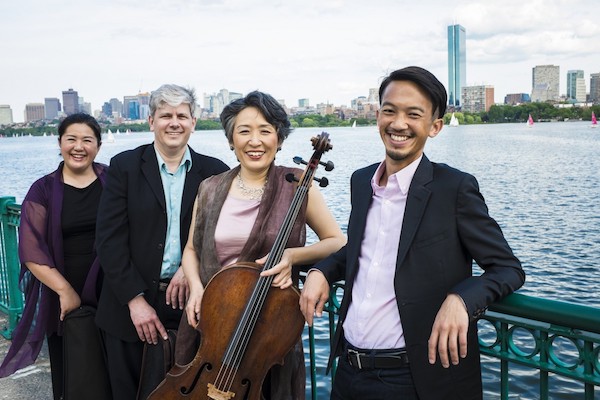A lesser-known Mendelssohn highlights Borromeo Quartet program at Gardner Museum

Felix Mendelssohn’s quartets have earned a respectable place in the repertoire, even if they’re not quite as popular as some of his other works. So where does that leave the lone quartet of his beloved sister Fanny, a prolific composer in her own right who is often still only known by association with her brother?
Saturday at the Isabella Stewart Gardner Museum’s Calderwood Hall, the Borromeo String Quartet finished the Mendelssohn string quartet cycle they began almost a year ago. They included Fanny’s string quartet alongside Felix’s third and fifth quartets, inviting comparisons and maybe some questions about who gets into the canon.
The BSQ are global superstars racking up performances, teaching opportunities and accolades worldwide. They’re also hometown favorites in Boston, where they’ve been New England Conservatory’s quartet in residence for 25 years (and formerly at the Gardner Museum for over 20 years). Audiences are bound to perk up even when this group is tackling lesser-known repertoire. This concert did earn an impressive turnout. Yet by its end, Fanny’s work demanded attention regardless of who might be playing it.
Based on a piano sonata and neither published nor performed in the composer’s lifetime, Fanny Mendelssohn’s String Quartet in E-flat rarely settles on one key for long. It maintains a constant air of striving for something it can never reach. Tense, reflective melodies are interrupted by agitated asides. Three of the four movements end abruptly and sardonically with no grand cadences or climactic codas.
It opens with a gloomy Adagio ma non troppo that promises to turn hopeful but always swerves into deeper despair. Airtight phrasing and dynamics by the Borromeo shaped these restless harmonies into a compelling narrative. First violinist Nicholas Kitchen’s sweet tone added an earnest touch to the lead. Unfortunately, here and throughout the evening, second violinist Kristopher Tong was often drowned out in the mix. The succeeding Allegretto began preciously before a crushing fugue and bold entrances by violist Mai Motobuchi and cellist Yeesun Kim. Passages of massed power and agility traded off among all four players, including some frighteningly fast runs by Kim.
Rapid vibrato and angular attacks added a sense of ambiguity to the descending phrases of the plaintive Romanze. The Allegro molto vivace, with its clearly defined key and sparkling theme, seemed like a black joke of a finale by the composer, seized upon by the BSQ with bracing momentum.
Placing this melancholy work in the center of the program already gave the work its own gravity. Next to Fanny Mendelssohn’s piece, Felix’s perhaps more formally expansive works somehow now seemed glib.
Felix Mendelssohn’s Opus 44 was written during a happy time in the already upbeat composer’s life. He had just returned from his honeymoon, was enjoying his prominent position as conductor of the Leipzig Gewandhaus Orchestra and gaining respect as an authority on Bach. The three quartets in this set were intended for violinist Ferdinand David’s group. David was both Felix’s close friend and a virtuoso who would later premiere his famous Violin Concerto in E Minor. Demanding yet tuneful with lots of subtle harmonic touches, the two Opus 44 quartets heard Saturday illustrate the composer synthesis of Classical form and Romantic emotion.
Some issues with pitch aside, the Borromeo String Quartet handled Felix’s music with polish and personality. The rocketing first movement of String Quartet No. 3 in D Major (Op. 44, No. 1) was especially spry, yet the foursome shifted into more graceful asides on a dime. The succeeding Menuetto showed off their warm darker colors. Kitchen’s long lines in the Andante espressivo ma con molto started out convincingly restrained before throbbing over a spacious backing.
At several points in the piece, Motobuchi’s viola took over with a powerful lead, and Kim’s cello served as both a firm anchor in bass lines and a moving soloist in the upper register. The closing Presto con brio returned to the surging feel of the first movement. Tremolos passed between the four strings like the registers on a single instrument.
The jogging Allegro assai appassionato that opens Felix’s String Quartet No. 5 in E-flat (Op. 44, No. 3) also had plenty of bite. The fugal Scherzo receded into the claustrophobia of the ensemble’s dense blend and chattering attack, while the patient Andante was an opportunity to luxuriate in the BSQ’s purity of tone and the composer’s gradual but inevitable harmonic resolutions.
Amidst the unbridled propulsion of the concluding Presto agitato, the Borromeo String Quartet still found room for dancelike delivery — Kitchen wasn’t the only one bopping his head — and they clearly savored Mendelssohn’s songlike interludes.
Posted in Performances